The Cambridge History of China. Vol. 06. Alien Regimes and Border States, 907-1368
Подождите немного. Документ загружается.

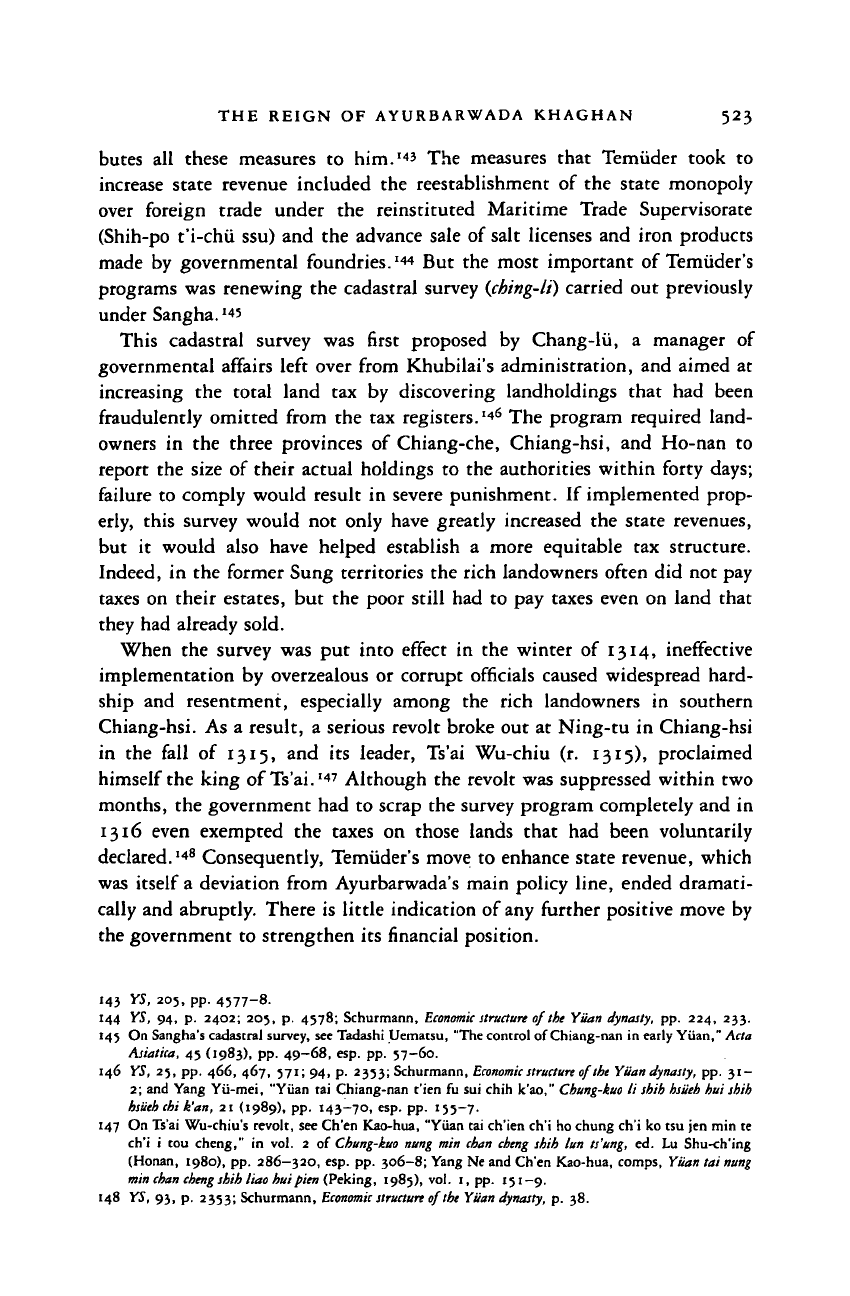
THE REIGN OF AYURBARWADA KHAGHAN 523
butes all these measures to him.'
4
' The measures that Temiider took to
increase state revenue included the reestablishment of the state monopoly
over foreign trade under the reinstituted Maritime Trade Supervisorate
(Shih-po t'i-chii ssu) and the advance sale of salt licenses and iron products
made by governmental foundries.
I44
But the most important of Temiider's
programs was renewing the cadastral survey (ching-li) carried out previously
under Sangha.
14
'
This cadastral survey was first proposed by Chang-lii, a manager of
governmental affairs left over from Khubilai's administration, and aimed at
increasing the total land tax by discovering landholdings that had been
fraudulently omitted from the tax registers.'
46
The program required land-
owners in the three provinces of Chiang-che, Chiang-hsi, and Ho-nan to
report the size of their actual holdings to the authorities within forty days;
failure to comply would result in severe punishment. If implemented prop-
erly, this survey would not only have greatly increased the state revenues,
but it would also have helped establish a more equitable tax structure.
Indeed, in the former Sung territories the rich landowners often did not pay
taxes on their estates, but the poor still had to pay taxes even on land that
they had already sold.
When the survey was put into effect in the winter of 1314, ineffective
implementation by overzealous or corrupt officials caused widespread hard-
ship and resentment, especially among the rich landowners in southern
Chiang-hsi. As a result, a serious revolt broke out at Ning-tu in Chiang-hsi
in the fall of 1315, and its leader, Ts'ai Wu-chiu (r. 1315), proclaimed
himself the king of Ts'ai.
I47
Although the revolt was suppressed within two
months, the government had to scrap the survey program completely and in
1316 even exempted the taxes on those lands that had been voluntarily
declared.
148
Consequently, Temiider's move to enhance state revenue, which
was itself a deviation from Ayurbarwada's main policy line, ended dramati-
cally and abruptly. There is little indication of any further positive move by
the government to strengthen its financial position.
143 YS, 205, pp. 4577-8.
144 YS, 94, p. 2402; 205, p. 4578; Schurmann,
Economic
structun of
the
Yuan dynasty, pp. 224, 233.
145 On Sangha's cadastral survey, see Tadashi Uematsu, "The control of Chiang-nan in early Yuan," Ada
Asiatica, 45 (1983), pp. 49—68, esp. pp. 57-60.
146 YS, 25, pp. 466, 467, 571; 94, p. 2353; Schurmann,
Economic structure
0/the
Yuan dynasty, pp. 31-
2;
and Yang Yii-mei, "Yuan tai Chiang-nan t'ien fu sui chih k'ao," Chung-kuo It shih
hsu'eh
hui shih
hstieh
chi k'an, 21 (1989), pp. 143—70, esp. pp. 155-7.
147 On Ts'ai Wu-chiu's revolt, see Ch'en Kao-hua, "Yuan tai ch'ien ch'i ho chung ch'i ko tsu jen min te
ch'i i tou cheng," in vol. 2 of Chung-kuo nung min chan
cbeng
shih lun ts'ung, ed. Lu Shu-ch'ing
(Honan, 1980), pp. 286-320, esp. pp. 306-8; Yang Ne and Ch'en Kao-hua, comps, Yuan tai
nung
min
chan cheng
shih liao hui pien (Peking, 1985), vol. 1, pp. 151—9.
148 YS, 93, p. 2353; Schurmann,
Economic structure
of
the
Yuan dynasty, p. 38.
Cambridge Histories Online © Cambridge University Press, 2008
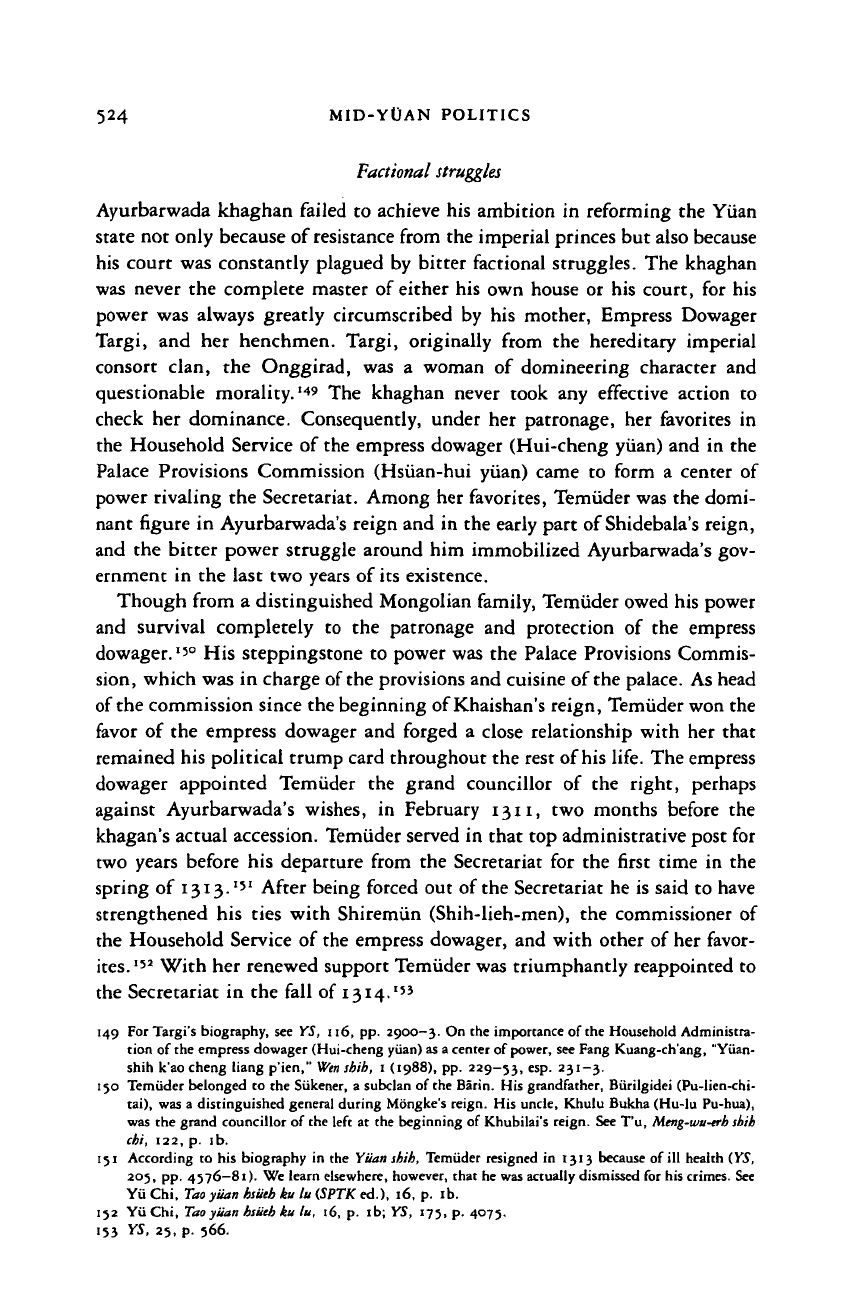
524 MID-YOAN POLITICS
Factional struggles
Ayurbarwada khaghan failed to achieve his ambition in reforming the Yuan
state not only because of resistance from the imperial princes but also because
his court was constantly plagued by bitter factional struggles. The khaghan
was never the complete master of either his own house or his court, for his
power was always greatly circumscribed by his mother, Empress Dowager
Targi, and her henchmen. Targi, originally from the hereditary imperial
consort clan, the Onggirad, was a woman of domineering character and
questionable morality.'
49
The khaghan never took any effective action to
check her dominance. Consequently, under her patronage, her favorites in
the Household Service of the empress dowager (Hui-cheng yuan) and in the
Palace Provisions Commission (Hsiian-hui yuan) came to form a center of
power rivaling the Secretariat. Among her favorites, Temiider was the domi-
nant figure in Ayurbarwada's reign and in the early part of Shidebala's reign,
and the bitter power struggle around him immobilized Ayurbarwada's gov-
ernment in the last two years of its existence.
Though from a distinguished Mongolian family, Temiider owed his power
and survival completely to the patronage and protection of the empress
dowager.
1
'
0
His steppingstone to power was the Palace Provisions Commis-
sion, which was in charge of
the
provisions and cuisine of
the
palace. As head
of the commission since the beginning of Khaishan's reign, Temiider won the
favor of the empress dowager and forged a close relationship with her that
remained his political trump card throughout the rest of his life. The empress
dowager appointed Temiider the grand councillor of the right, perhaps
against Ayurbarwada's wishes, in February 1311, two months before the
khagan's actual accession. Temiider served in that top administrative post for
two years before his departure from the Secretariat for the first time in the
spring of
1313.
151
After being forced out of the Secretariat he is said to have
strengthened his ties with Shiremiin (Shih-lieh-men), the commissioner of
the Household Service of the empress dowager, and with other of her favor-
ites.
152
With her renewed support Temiider was triumphantly reappointed to
the Secretariat in the fall of
149 For Targi's biography, see YS, 116, pp. 2900—3. On che importance of the Household Administra-
tion of the empress dowager (Hui-cheng yuan) as a center of power, see Fang Kuang-ch'ang, "Yiian-
shih k'ao cheng liang p'ien,"
Wen
shih, 1 (1988), pp. 229-53,
es
P-
2
3
I-
3-
150 Temiider belonged to the Siikener, a subclan of the Barin. His grandfather, Biirilgidei (Pu-lien-chi-
tai),
was a distinguished general during Mongke's reign. His uncle, Khulu Bukha (Hu-lu Pu-hua),
was the grand councillor of the left at the beginning of Khubilai's reign. See T'u,
Meng-wu-erb
sbih
chi, 122, p. ib.
151 According to his biography in the Yuan Mb, Temiider resigned in 1313 because of ill health (YS,
205,
pp. 4576-81). We learn elsewhere, however, that he was actually dismissed for his crimes. See
Yii Chi,
Tao
yuan
hsiieh
ku lu (SPTK ed.), 16, p. ib.
152 Yii Chi,
Tao
yuan hsiieb ku lu, 16, p. ib; YS, 175, p. 4075.
153 YS, 25, p. 566.
Cambridge Histories Online © Cambridge University Press, 2008
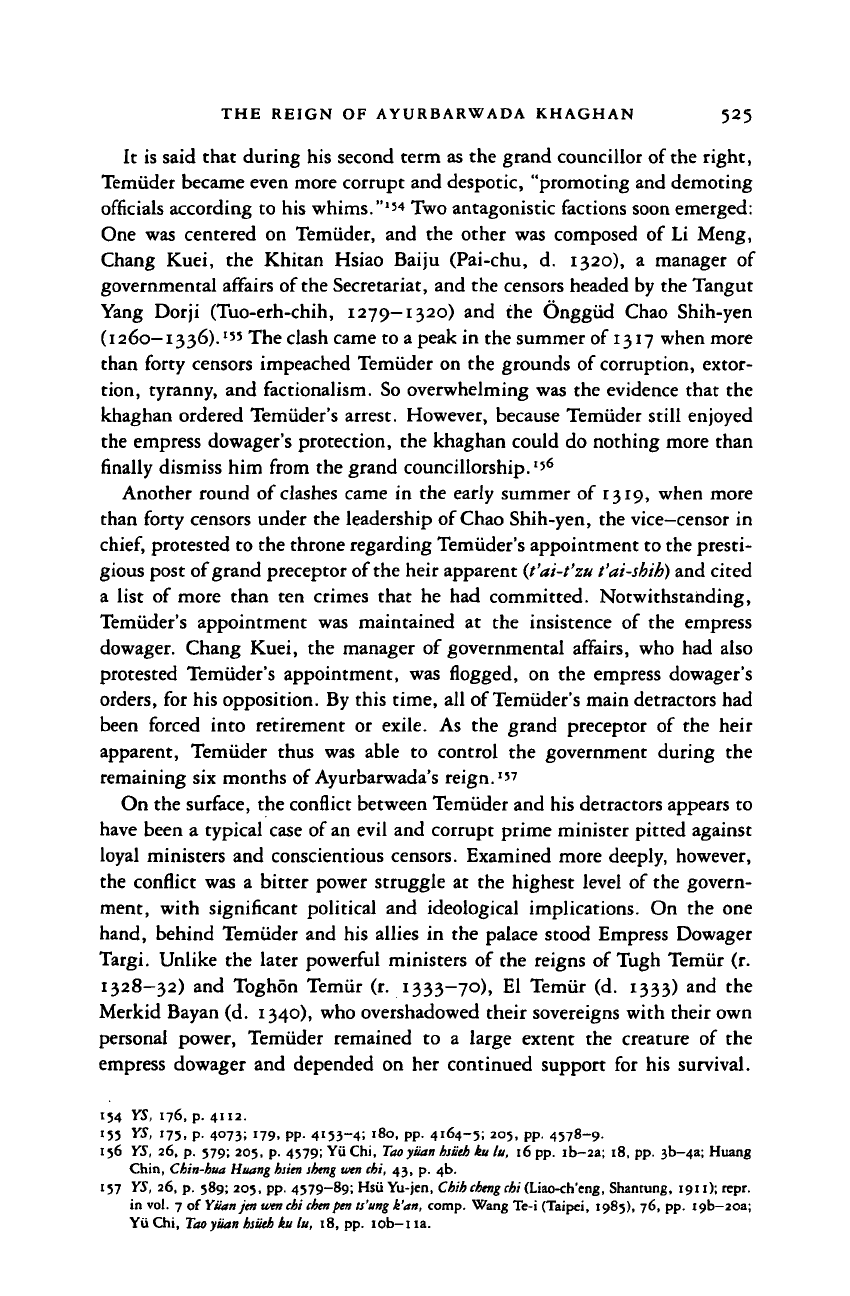
THE REIGN
OF
AYURBARWADA KHAGHAN
525
It
is
said that during
his
second term
as the
grand councillor
of
the right,
Temiider became even more corrupt and despotic, "promoting and demoting
officials according
to
his whims."
1
'
4
Two antagonistic factions soon emerged:
One
was
centered
on
Temiider,
and the
other
was
composed
of
Li Meng,
Chang Kuei,
the
Khitan Hsiao Baiju (Pai-chu,
d.
1320),
a
manager
of
governmental affairs of
the
Secretariat,
and the
censors headed
by
the Tangut
Yang Dorji (Tuo-erh-chih, 1279-1320)
and the
Onggiid Chao Shih-yen
(1260-1336).
l
»
The clash came
to
a peak
in
the summer
of
1317 when more
than forty censors impeached Temiider
on the
grounds
of
corruption, extor-
tion, tyranny,
and
factionalism.
So
overwhelming was
the
evidence that
the
khaghan ordered Temiider's arrest. However, because Temiider still enjoyed
the empress dowager's protection,
the
khaghan could
do
nothing more than
finally dismiss
him
from the grand councillorship.
''
6
Another round
of
clashes
came
in the
early summer
of
1319, when more
than forty censors under
the
leadership of
Chao
Shih-yen, the vice-censor
in
chief,
protested
to
the throne regarding Temiider's appointment to the presti-
gious post of grand preceptor of
the
heir apparent
(t'ai-t'zu
t'ai-shih)
and cited
a list
of
more than
ten
crimes that
he had
committed. Notwithstanding,
Temiider's appointment
was
maintained
at the
insistence
of the
empress
dowager. Chang Kuei,
the
manager
of
governmental affairs,
who had
also
protested Temiider's appointment,
was
flogged,
on the
empress dowager's
orders,
for
his opposition. By this time,
all
of Temiider's main detractors had
been forced into retirement
or
exile.
As the
grand preceptor
of the
heir
apparent, Temiider thus
was
able
to
control
the
government during
the
remaining
six
months
of
Ayurbarwada's reign.
1
"
On the surface, the conflict between Temuder and his detractors appears
to
have been
a
typical case
of
an
evil
and
corrupt prime minister pitted against
loyal ministers
and
conscientious censors. Examined more deeply, however,
the conflict
was a
bitter power struggle
at the
highest level
of
the govern-
ment, with significant political
and
ideological implications.
On the one
hand, behind Temuder
and his
allies
in the
palace stood Empress Dowager
Targi. Unlike
the
later powerful ministers
of the
reigns
of
Tugh Temiir
(r.
1328-32)
and
Toghon Temiir
(r.
1333-70),
El
Temiir
(d. 1333) and the
Merkid Bayan (d. 1340), who overshadowed their sovereigns with their own
personal power, Temuder remained
to a
large extent
the
creature
of the
empress dowager
and
depended
on her
continued support
for his
survival.
154 YS, 176, p. 4112.
155 YS, 175, p. 4073; 179, pp. 4153-4; 180, pp. 4164-5; 205, pp. 4578-9.
156 YS, 26, p. 579; 205, p. 4579; Yii Chi,
Taoyuan hsiieb
kit /», 16 pp. ib—2a; 18, pp. 3b—4a; Huang
Chin, Chin-hua Huang hsitn
sheng wen
chi,
43, p. 4b.
157
YS, 26, p.
589;
205, pp.
4579—89;
Hsu
Yu-jen, Chih chmg chi (Liao-ch'eng, Shantung, 1911); repr.
in
vol. 7 of
Yuan
Jen wen
chi
then pen ts'ung
k'an, comp. Wang
Te-i
(Taipei, 1985),
76, pp.
19b—20a;
Yu
Chi,
Too
yuan
hsueh
ku lu, 18, pp.
lob-na.
Cambridge Histories Online © Cambridge University Press, 2008
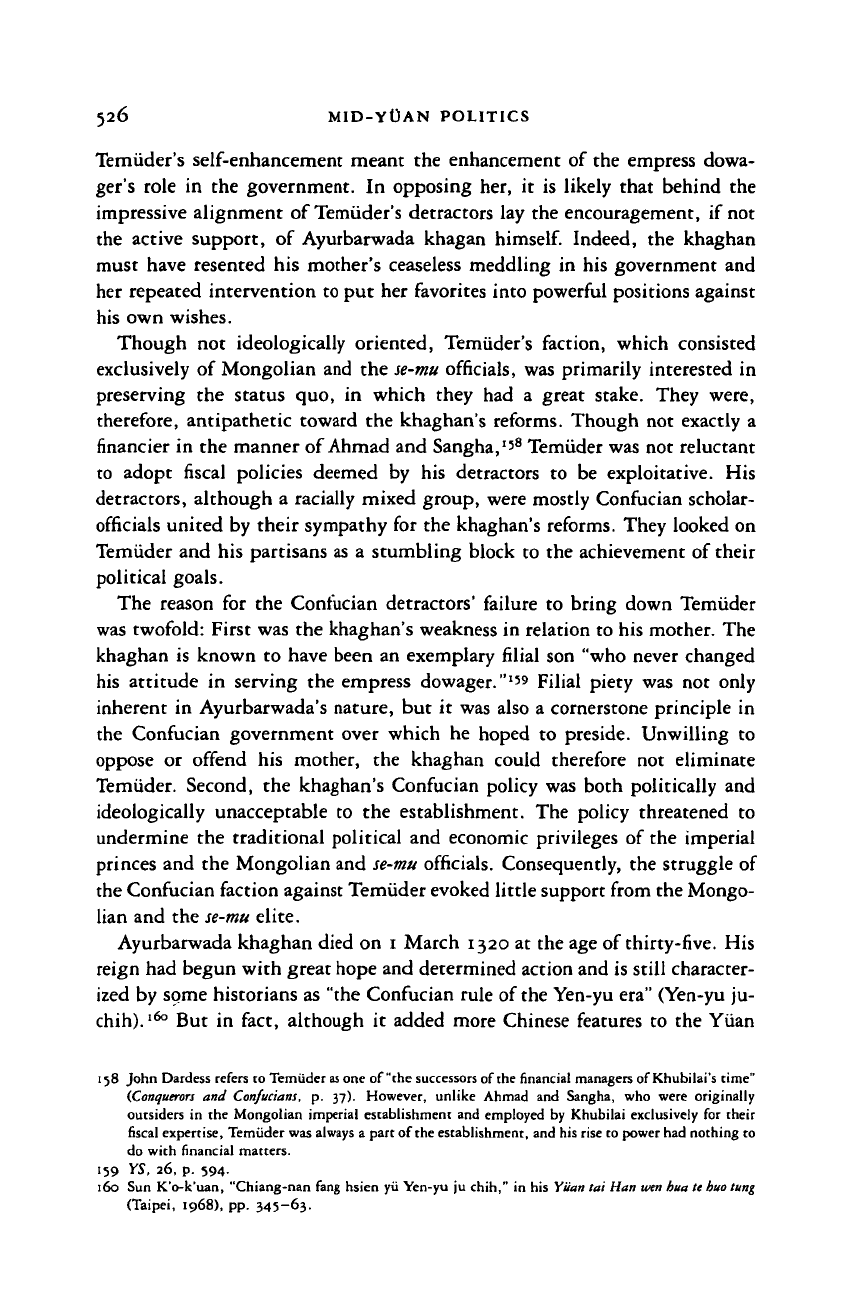
526 MID-YOAN POLITICS
Temiider's self-enhancement meant the enhancement of the empress dowa-
ger's role in the government. In opposing her, it is likely that behind the
impressive alignment of Temiider's detractors lay the encouragement, if not
the active support, of Ayurbarwada khagan
himself.
Indeed, the khaghan
must have resented his mother's ceaseless meddling in his government and
her repeated intervention to put her favorites into powerful positions against
his own wishes.
Though not ideologically oriented, Temiider's faction, which consisted
exclusively of Mongolian and the
se-mu
officials, was primarily interested in
preserving the status quo, in which they had a great stake. They were,
therefore, antipathetic toward the khaghan's reforms. Though not exactly a
financier in the manner of Ahmad and Sangha,
1
'
8
Temiider was not reluctant
to adopt fiscal policies deemed by his detractors to be exploitative. His
detractors, although a racially mixed group, were mostly Confucian scholar-
officials united by their sympathy for the khaghan's reforms. They looked on
Temiider and his partisans as a stumbling block to the achievement of their
political goals.
The reason for the Confucian detractors' failure to bring down Temiider
was twofold: First was the khaghan's weakness in relation to his mother. The
khaghan is known to have been an exemplary filial son "who never changed
his attitude in serving the empress dowager."
159
Filial piety was not only
inherent in Ayurbarwada's nature, but it was also a cornerstone principle in
the Confucian government over which he hoped to preside. Unwilling to
oppose or offend his mother, the khaghan could therefore not eliminate
Temiider. Second, the khaghan's Confucian policy was both politically and
ideologically unacceptable to the establishment. The policy threatened to
undermine the traditional political and economic privileges of the imperial
princes and the Mongolian and
se-mu
officials. Consequently, the struggle of
the Confucian faction against Temiider evoked little support from the Mongo-
lian and the
se-mu
elite.
Ayurbarwada khaghan died on
1
March 1320 at the age of thirty-five. His
reign had begun with great hope and determined action and is still character-
ized by some historians as "the Confucian rule of the Yen-yu era" (Yen-yu ju-
chih).
l6
° But in fact, although it added more Chinese features to the Yuan
158 John Dardess refers to Temiider
as
one of "the successors of the financial managers of Khubilai's time"
(Conquerors and Confucians, p. 37). However, unlike Ahmad and Sangha, who were originally
outsiders in the Mongolian imperial establishment and employed by Khubilai exclusively for their
fiscal expertise, Temiider was always a part of the establishment, and his rise to power had nothing to
do with financial matters.
159 YS, 26, p. 594.
160 Sun K'o-k'uan, "Chiang-nan fang hsien yii Yen-yu ju chih," in his Yuan tai Han wen hua le
huo
lung
(Taipei, 1968), pp. 345-63.
Cambridge Histories Online © Cambridge University Press, 2008
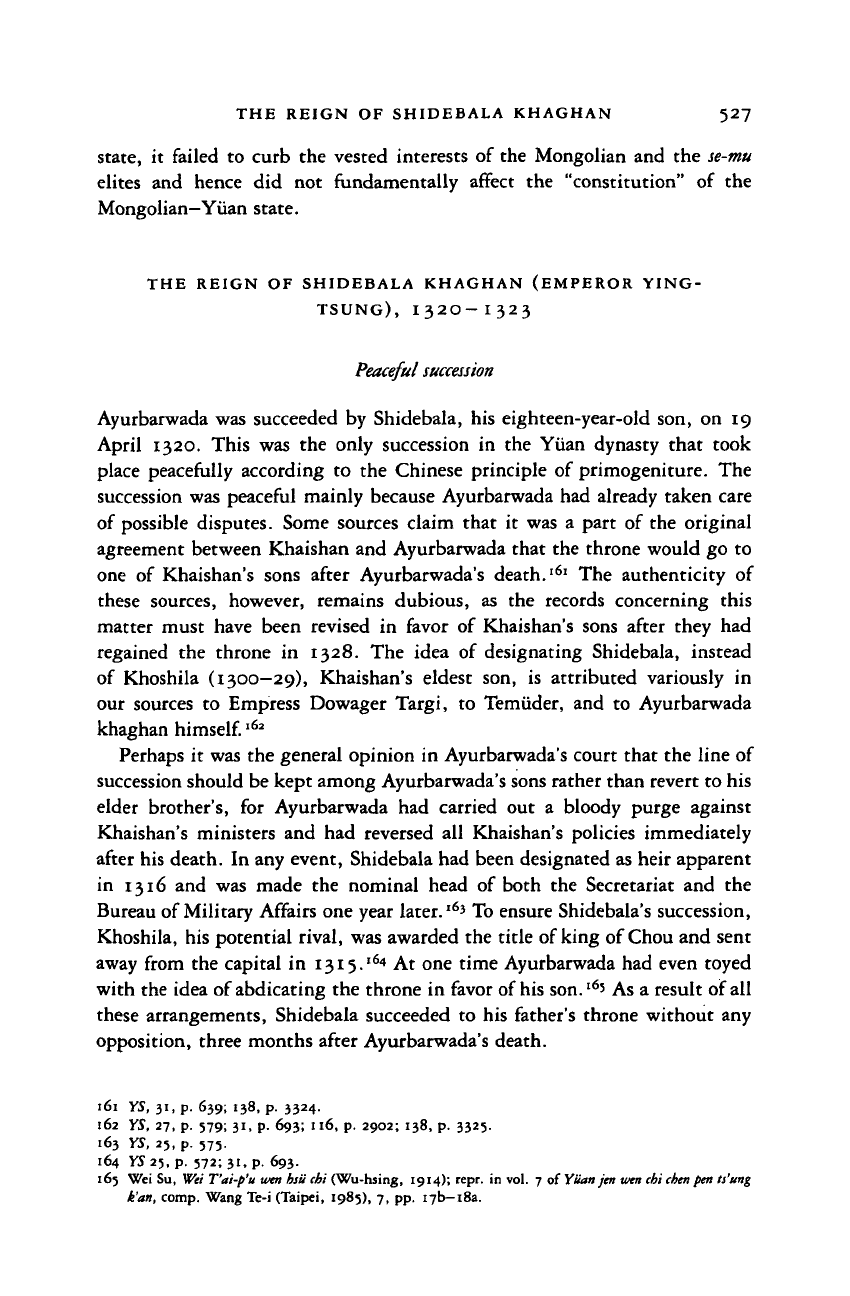
THE REIGN OF SHIDEBALA KHAGHAN 527
state,
it failed to curb the vested interests of the Mongolian and the
se-mu
elites and hence did not fundamentally affect the "constitution" of the
Mongolian—Yuan state.
THE
REIGN OF SHIDEBALA KHAGHAN (EMPEROR YING-
TSUNG),
1320-1323
Peaceful
succession
Ayurbarwada was succeeded by Shidebala, his eighteen-year-old son, on 19
April 1320. This was the only succession in the Yuan dynasty that took
place peacefully according to the Chinese principle of primogeniture. The
succession was peaceful mainly because Ayurbarwada had already taken care
of possible disputes. Some sources claim that it was a part of the original
agreement between Khaishan and Ayurbarwada that the throne would go to
one of Khaishan's sons after Ayurbarwada's death.
l6
' The authenticity of
these sources, however, remains dubious, as the records concerning this
matter must have been revised in favor of Khaishan's sons after they had
regained the throne in 1328. The idea of designating Shidebala, instead
of Khoshila (1300-29), Khaishan's eldest son, is attributed variously in
our sources to Empress Dowager Targi, to Temiider, and to Ayurbarwada
khaghan
himself.
l62
Perhaps it was the general opinion in Ayurbarwada's court that the line of
succession should be kept among Ayurbarwada's sons rather than revert to his
elder brother's, for Ayurbarwada had carried out a bloody purge against
Khaishan's ministers and had reversed all Khaishan's policies immediately
after his death. In any event, Shidebala had been designated as heir apparent
in 1316 and was made the nominal head of both the Secretariat and the
Bureau of Military Affairs one year later.'
63
To ensure Shidebala's succession,
Khoshila, his potential rival, was awarded the title of king of Chou and sent
away from the capital in I3i5.
l6
t At one time Ayurbarwada had even toyed
with the idea of abdicating the throne in favor of his son.'
6
' As a result of all
these arrangements, Shidebala succeeded to his father's throne without any
opposition, three months after Ayurbarwada's death.
161
YS,
31,
p.
639;
138,
p.
3324.
162
YS,
27,
p.
579;
31,
p.
693;
116,
p.
2902;
138,
p.
3325.
163
YS,
25,
p.
575.
164 YS
25,
p.
572;
31,
p.
693.
165 Wei Su, Wei
T'ai-p'u
wen hsii chi (Wu-hsing, 1914); repr. in vol. 7 of Yuan jen wen cbi
chen
pen ts'ung
fan,
comp. Wang Te-i (Taipei, 1985), 7, pp. 17b—18a.
Cambridge Histories Online © Cambridge University Press, 2008
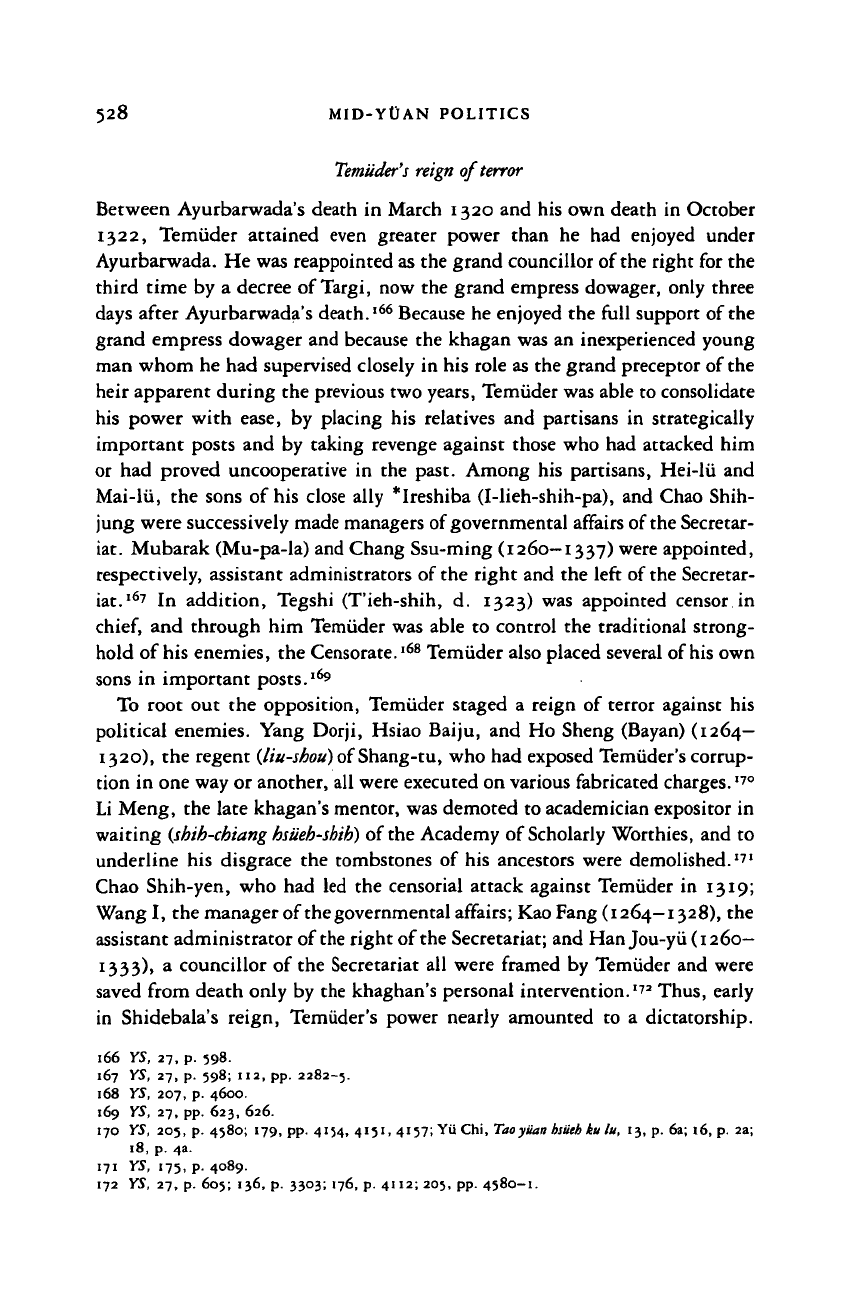
528 MID-YtiAN POLITICS
Temiider's reign of terror
Between Ayurbarwada's death in March 1320 and his own death in October
1322,
Temiider attained even greater power than he had enjoyed under
Ayurbarwada. He was reappointed as the grand councillor of
the
right for the
third time by a decree of
Targi,
now the grand empress dowager, only three
days after Ayurbarwada's death.'
66
Because he enjoyed the full support of the
grand empress dowager and because the khagan was an inexperienced young
man whom he had supervised closely in his role as the grand preceptor of the
heir apparent during the previous two years, Temiider was able to consolidate
his power with ease, by placing his relatives and partisans in strategically
important posts and by taking revenge against those who had attacked him
or had proved uncooperative in the past. Among his partisans, Hei-lii and
Mai-lii, the sons of his close ally *Ireshiba (I-lieh-shih-pa), and Chao Shih-
jung were successively made managers of governmental affairs of the Secretar-
iat. Mubarak (Mu-pa-la) and Chang Ssu-ming (1260—1337) were appointed,
respectively, assistant administrators of the right and the left of the Secretar-
iat.'
67
In addition, Tegshi (T'ieh-shih, d. 1323) was appointed censor in
chief,
and through him Temiider was able to control the traditional strong-
hold of his enemies, the Censorate.'
68
Temiider also placed several of
his
own
sons in important posts.'
69
To root out the opposition, Temiider staged a reign of terror against his
political enemies. Yang Dorji, Hsiao Baiju, and Ho Sheng (Bayan) (1264—
1320),
the regent
(liu-shou)
of Shang-tu, who had exposed Temiider's corrup-
tion in one way or another, all were executed on various fabricated charges.'
70
Li Meng, the late khagan's mentor, was demoted to academician expositor in
waiting
(shih-cbiang hsiieh-shih)
of the Academy of Scholarly Worthies, and to
underline his disgrace the tombstones of his ancestors were demolished.'
7
'
Chao Shih-yen, who had led the censorial attack against Temiider in 1319;
Wang I, the manager of
the
governmental affairs; Kao Fang (1264-1328), the
assistant administrator of
the
right of the Secretariat; and Han Jou-yii (1260-
1333),
a councillor of the Secretariat all were framed by Temiider and were
saved from death only by the khaghan's personal intervention.'
72
Thus, early
in Shidebala's reign, Temiider's power nearly amounted to a dictatorship.
166 YS, 27, p. 598.
167 YS, 27, p. 598; 112, pp. 2282-5.
168 YS, 207, p. 4600.
169 YS, 27, pp. 623, 626.
170 YS, 205, p. 4580; 179, pp. 4154, 4151, 4157; Yii Chi,
Too
yuan
bsiieh
ku lu, 13, p. 6a; 16, p. 2a;
18,
p. 4a.
171 YS, 175, p. 4089.
172 YS, 27, p. 605; 136, p. 3303; 176, p. 4112; 205, pp. 4580—1.
Cambridge Histories Online © Cambridge University Press, 2008
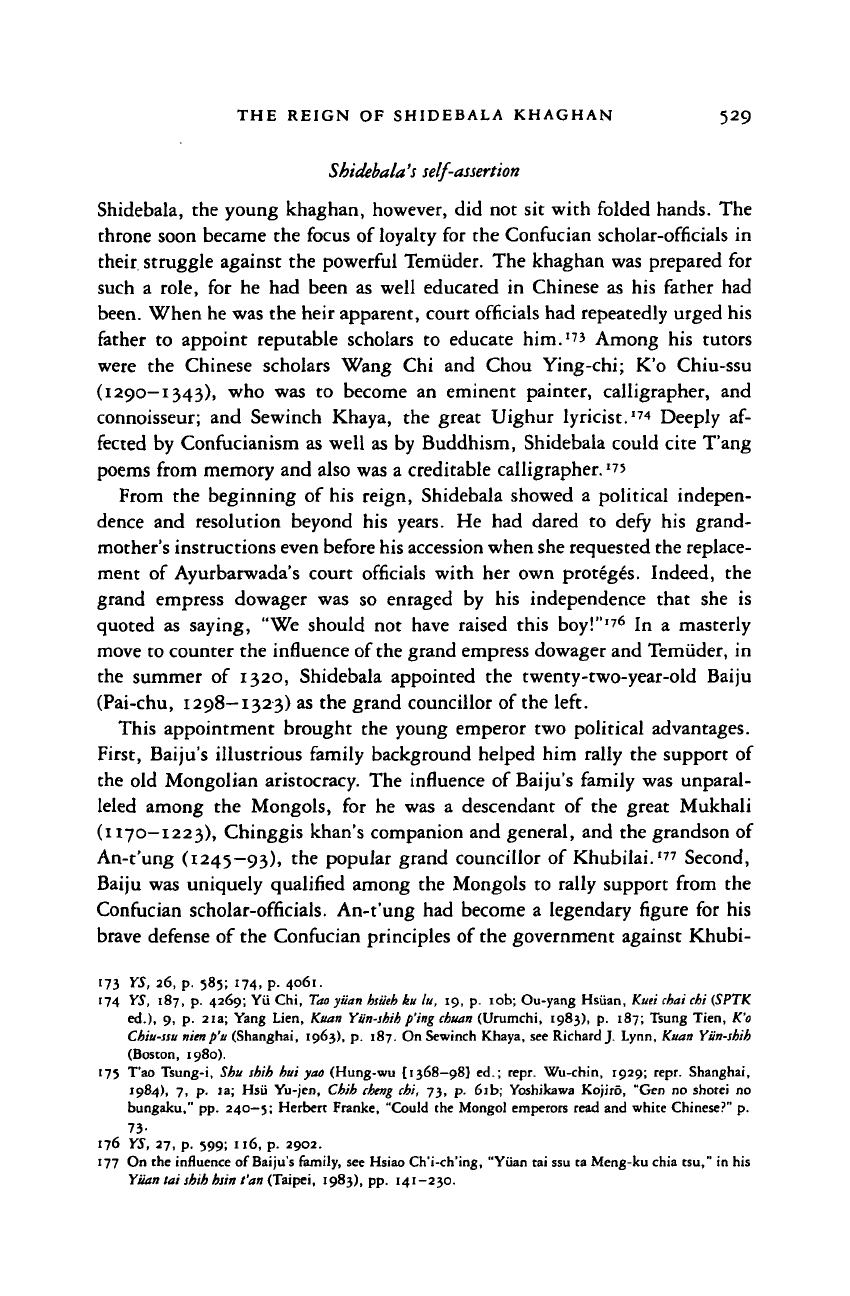
THE REIGN OF SHIDEBALA KHAGHAN 529
Shidebala's self-assertion
Shidebala, the young khaghan, however, did not sit with folded hands. The
throne soon became the focus of loyalty for the Confucian scholar-officials in
their, struggle against the powerful Temiider. The khaghan was prepared for
such a role, for he had been as well educated in Chinese as his father had
been. When he was the heir apparent, court officials had repeatedly urged his
father to appoint reputable scholars to educate him.
173
Among his tutors
were the Chinese scholars Wang Chi and Chou Ying-chi; K'o Chiu-ssu
(1290—1343), who was to become an eminent painter, calligrapher, and
connoisseur; and Sewinch Khaya, the great Uighur lyricist.
174
Deeply af-
fected by Confucianism as well as by Buddhism, Shidebala could cite T'ang
poems from memory and also was a creditable calligrapher.
1
T>
From the beginning of his reign, Shidebala showed a political indepen-
dence and resolution beyond his years. He had dared to defy his grand-
mother's instructions even before his accession when she requested the replace-
ment of Ayurbarwada's court officials with her own proteges. Indeed, the
grand empress dowager was so enraged by his independence that she is
quoted as saying, "We should not have raised this boy!"'
76
In a masterly
move to counter the influence of the grand empress dowager and Temiider, in
the summer of 1320, Shidebala appointed the twenty-two-year-old Baiju
(Pai-chu, 1298—1323) as the grand councillor of the left.
This appointment brought the young emperor two political advantages.
First, Baiju's illustrious family background helped him rally the support of
the old Mongolian aristocracy. The influence of Baiju's family was unparal-
leled among the Mongols, for he was a descendant of the great Mukhali
(1170—1223), Chinggis khan's companion and general, and the grandson of
An-t'ung (1245—93), the popular grand councillor of Khubilai.
177
Second,
Baiju was uniquely qualified among the Mongols to rally support from the
Confucian scholar-officials. An-t'ung had become a legendary figure for his
brave defense of the Confucian principles of the government against Khubi-
173 YS, 26, p. 585; 174, p. 4061.
174 YS, 187, p. 4269; Yii Chi,
Too
yuan
hsiieh
ku lu, 19, p. 10b; Ou-yang Hsiian, Kuei chai chi (SPTK
ed.),
9, p. 21a; Yang Lien, Kuan Yiin-shih
p'ing
chuan
(Urumchi, 1983), p. 187; Tsung Tien, K'o
Chiu-ssu nimp'u (Shanghai, 1963), p. 187. On Sewinch Khaya, see Richard J. Lynn, Kuan Yiin-sbih
(Boston, 1980).
175 T'ao Tsung-i, Shu shih hui you (Hung-wu [1368-98} ed.; repr. Wu-chin, 1929; repr. Shanghai,
1984),
7, p. la; Hsu Yu-jen, Chih
cheng
chi, 73, p. 61b; Yoshikawa Kojiro, "Gen no shotei no
bungaku," pp. 240—5; Herbert Franke, "Could the Mongol emperors read and white Chinese?" p.
73-
176 YS, 27, p. 599; 116, p. 2902.
177 On the influence of Baiju's family, see Hsiao Ch'i-ch'ing, "Yuan tai ssu ta Meng-ku chia tsu," in his
Yuan lai shih hiin t'an (Taipei, 1983), pp. 141-230.
Cambridge Histories Online © Cambridge University Press, 2008
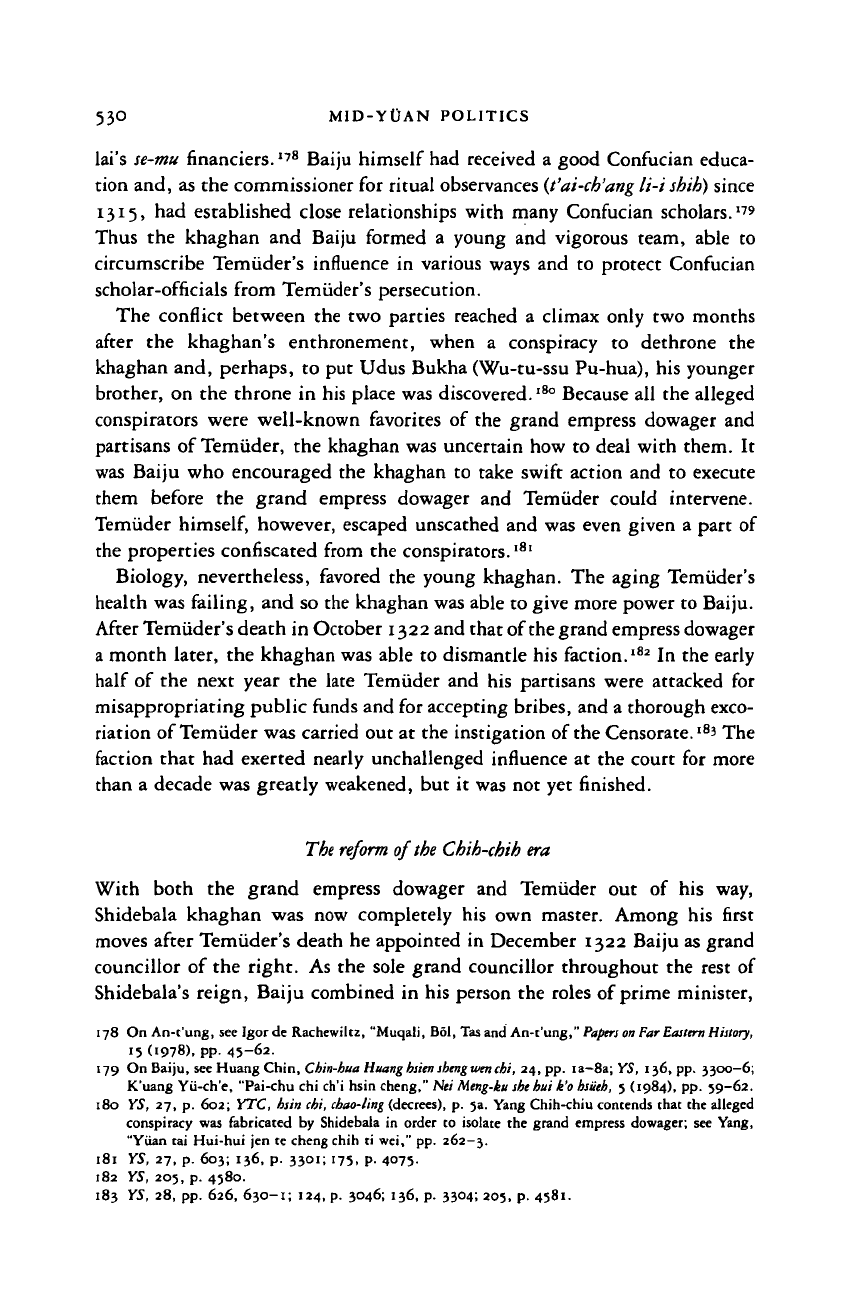
53° MID-YOAN POLITICS
lai's se-mu financiers.
178
Baiju himself had received a good Confucian educa-
tion and, as the commissioner for ritual observances (t'ai-ch'ang li-i
shih)
since
1315,
had established close relationships with many Confucian scholars.
179
Thus the khaghan and Baiju formed a young and vigorous team, able to
circumscribe Temiider's influence in various ways and to protect Confucian
scholar-officials from Temiider's persecution.
The conflict between the two parties reached a climax only two months
after the khaghan's enthronement, when a conspiracy to dethrone the
khaghan and, perhaps, to put Udus Bukha (Wu-tu-ssu Pu-hua), his younger
brother, on the throne in his place was discovered.
l8
° Because all the alleged
conspirators were well-known favorites of the grand empress dowager and
partisans of Temiider, the khaghan was uncertain how to deal with them. It
was Baiju who encouraged the khaghan to take swift action and to execute
them before the grand empress dowager and Temiider could intervene.
Temiider
himself,
however, escaped unscathed and was even given a part of
the properties confiscated from the conspirators.
18
'
Biology, nevertheless, favored the young khaghan. The aging Temiider's
health was failing, and so the khaghan was able to give more power to Baiju.
After Temiider's death in October 1322 and that of the grand empress dowager
a month later, the khaghan was able to dismantle his faction.
182
In the early
half of the next year the late Temiider and his partisans were attacked for
misappropriating public funds and for accepting bribes, and a thorough exco-
riation of Temiider was carried out at the instigation of the Censorate.
l8
3 The
faction that had exerted nearly unchallenged influence at the court for more
than a decade was greatly weakened, but it was not yet finished.
The
reform
of the Chih-chih
era
With both the grand empress dowager and Temiider out of his way,
Shidebala khaghan was now completely his own master. Among his first
moves after Temiider's death he appointed in December 1322 Baiju as grand
councillor of the right. As the sole grand councillor throughout the rest of
Shidebala's reign, Baiju combined in his person the roles of prime minister,
178 On An-t'ung, see Igor de Rachewiltz, "Muqali, B6I, Tas and An-t'ung,"
Papers on
Far
Eastern
History,
15 (1978), PP- 45-62-
179 On Baiju, see Huang Chin, Cbm-hua Huang
hsiensheng wen
chi, 24, pp. ia—8a; YS, 136, pp. 3300—6;
K'uang Yii-ch'e, "Pai-chu chi ch'i hsin cheng," Nei
Meng-ku she
hui k'o
hsiieh,
5 (1984), pp. 59-62.
180 YS, 27, p. 602; YTC, hsin chi, chao-ling (decrees), p. 5a. Yang Chih-chiu contends that the alleged
conspiracy was fabricated by Shidebala in order to isolate the grand empress dowager; see Yang,
"Yuan tai Hui-hui jen te cheng chih ti wei," pp. 262-3.
181 YS,
27,
p.
603;
136,
p.
3301;
175,
p.
4075.
182 YS,
205,
p.
4580.
183 YS,
28,
pp.
626,
630—1;
124,
p.
3046;
136,
p.
3304;
205,
p.
4581.
Cambridge Histories Online © Cambridge University Press, 2008
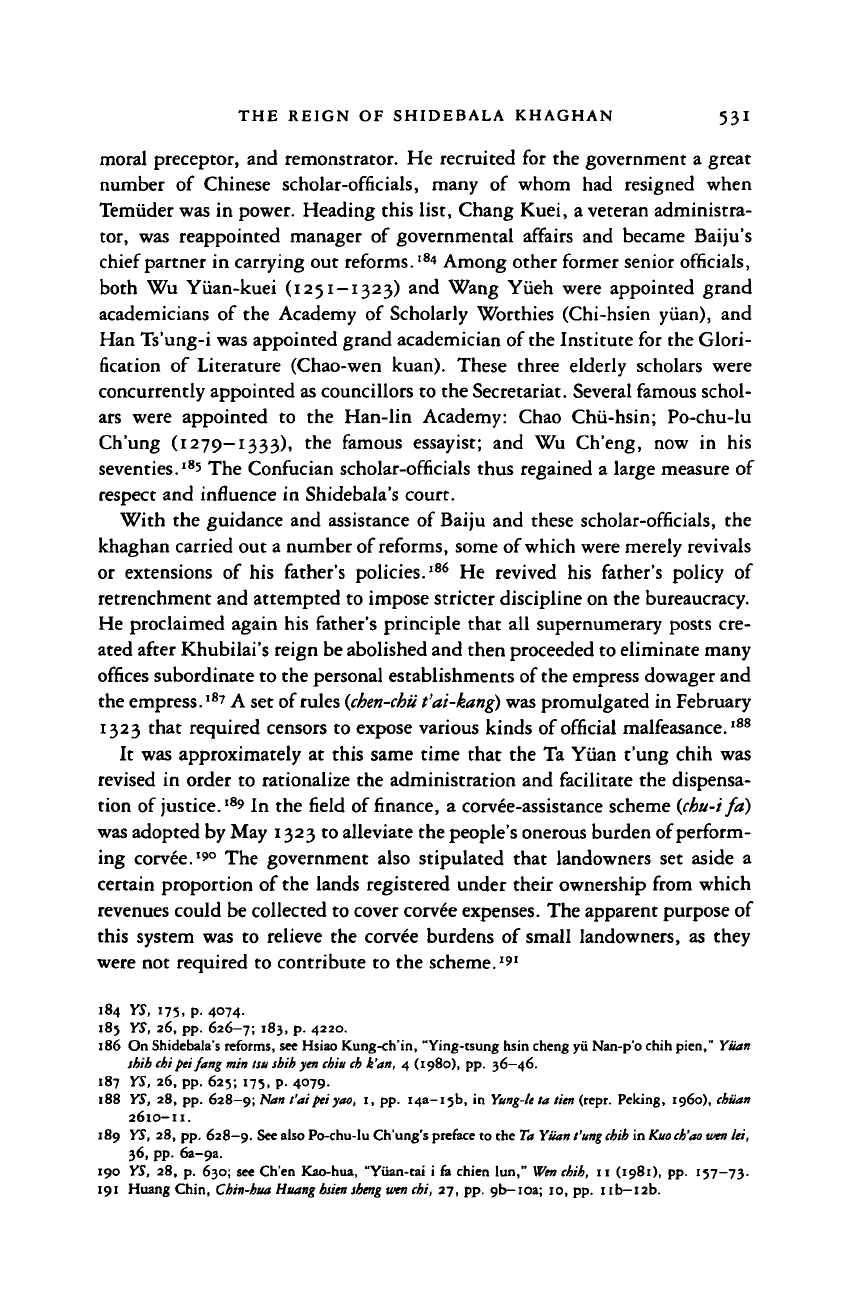
THE REIGN OF SHIDEBALA KHAGHAN 531
moral preceptor, and remonstrator. He recruited for the government a great
number of Chinese scholar-officials, many of whom had resigned when
Temiider was in power. Heading this list, Chang Kuei, a veteran administra-
tor, was reappointed manager of governmental affairs and became Baiju's
chief partner in carrying out reforms.
l84
Among other former senior officials,
both Wu Yiian-kuei (1251-1323) and Wang Yiieh were appointed grand
academicians of the Academy of Scholarly Worthies (Chi-hsien yuan), and
Han Ts'ung-i was appointed grand academician of the Institute for the Glori-
fication of Literature (Chao-wen kuan). These three elderly scholars were
concurrently appointed as councillors to the Secretariat. Several famous schol-
ars were appointed to the Han-lin Academy: Chao Chii-hsin; Po-chu-lu
Ch'ung (1279-1333), the famous essayist; and Wu Ch'eng, now in his
seventies.
185
The Confucian scholar-officials thus regained a large measure of
respect and influence in Shidebala's court.
With the guidance and assistance of Baiju and these scholar-officials, the
khaghan carried out a number of reforms, some of which were merely revivals
or extensions of his father's policies.
186
He revived his father's policy of
retrenchment and attempted to impose stricter discipline on the bureaucracy.
He proclaimed again his father's principle that all supernumerary posts cre-
ated after Khubilai's reign be abolished and then proceeded to eliminate many
offices subordinate to the personal establishments of the empress dowager and
the empress.
l87
A set of rules
(chen-chu
t'ai-kang) was promulgated in February
1323 that required censors to expose various kinds of official malfeasance.'
88
It was approximately at this same time that the Ta Yuan t'ung chih was
revised in order to rationalize the administration and facilitate the dispensa-
tion of justice.'
89
In the field of finance, a corvee-assistance scheme
(chu-i
fa)
was adopted by May 1323 to alleviate the people's onerous burden of perform-
ing corvee.'
90
The government also stipulated that landowners set aside a
certain proportion of the lands registered under their ownership from which
revenues could be collected to cover corvee expenses. The apparent purpose of
this system was to relieve the corvee burdens of small landowners, as they
were not required to contribute to the scheme.'
9
'
184 YS, 175. P- 4°74-
185 YS, 26, pp. 626-7; 183, p. 4220.
186 On Shidebala's reforms, see Hsiao Kung-ch'in, "Ying-tsung hsin cheng yii Nan-p'o chih pien," Yiian
shih
chi
pel fang min liu shih yen
chiu ch
k'an, 4 (1980), pp. 36—46.
187 YS, 26, pp. 625; 175, p. 4079.
188 YS, 28, pp. 628-9;
Nan
t'aipeiyao, 1, pp. I4a-ijb, in
Yung-le
ta tien (repr. Peking, i960), chiian
2610-11.
189 YS, 28, pp. 628—9. See also Po-chu-lu Ch'ung's preface to the Ta Yiian
t'ung
chih
in
Kuo ch'ao wen
lei,
36,
pp. 6a~9a.
190 YS, 28, p. 630; see Ch'en Kao-hua, "Yiian-tai i fa chien lun,"
Wen
chih, 11 (1981), pp. 157—73.
191 Huang Chin, Chin-hua Huang hum
sheng
wen chi, 27, pp. 9b—10a; 10, pp.
1
ib—12b.
Cambridge Histories Online © Cambridge University Press, 2008
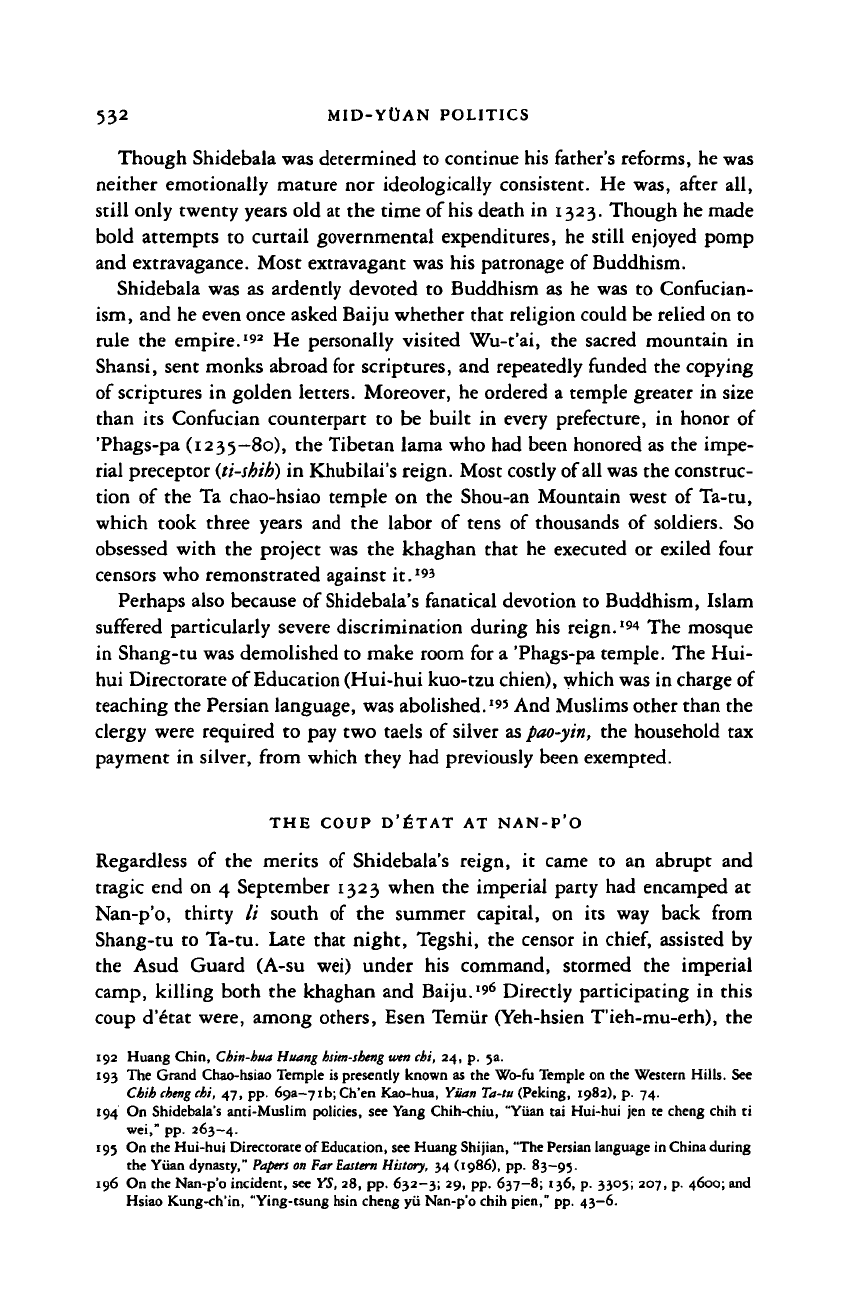
532 MID-YOAN POLITICS
Though Shidebala was determined to continue his father's reforms, he was
neither emotionally mature nor ideologically consistent. He was, after all,
still only twenty years old at the time of
his
death in 1323. Though he made
bold attempts to curtail governmental expenditures, he still enjoyed pomp
and extravagance. Most extravagant was his patronage of Buddhism.
Shidebala was as ardently devoted to Buddhism as he was to Confucian-
ism, and he even once asked Baiju whether that religion could be relied on to
rule the empire.'^
2
He personally visited Wu-t'ai, the sacred mountain in
Shansi, sent monks abroad for scriptures, and repeatedly funded the copying
of scriptures in golden letters. Moreover, he ordered a temple greater in size
than its Confucian counterpart to be built in every prefecture, in honor of
'Phags-pa (1235-80), the Tibetan lama who had been honored as the impe-
rial preceptor
(ti-shih)
in Khubilai's reign. Most costly of all was the construc-
tion of the Ta chao-hsiao temple on the Shou-an Mountain west of Ta-tu,
which took three years and the labor of tens of thousands of soldiers. So
obsessed with the project was the khaghan that he executed or exiled four
censors who remonstrated against it.*93
Perhaps also because of Shidebala's fanatical devotion to Buddhism, Islam
suffered particularly severe discrimination during his reign.'« The mosque
in Shang-tu was demolished to make room for a 'Phags-pa temple. The Hui-
hui Directorate of Education (Hui-hui kuo-tzu chien), which was in charge of
teaching the Persian language, was abolished.
195
And Muslims other than the
clergy were required to pay two taels of silver
as
pao-yin,
the household tax
payment in silver, from which they had previously been exempted.
THE COUP D'feTAT AT NAN-P'O
Regardless of the merits of Shidebala's reign, it came to an abrupt and
tragic end on 4 September 1323 when the imperial party had encamped at
Nan-p'o, thirty // south of the summer capital, on its way back from
Shang-tu to Ta-tu. Late that night, Tegshi, the censor in
chief,
assisted by
the Asud Guard (A-su wei) under his command, stormed the imperial
camp,
killing both the khaghan and Baiju.
l
?
6
Directly participating in this
coup d'etat were, among others, Esen Temiir (Yeh-hsien T'ieh-mu-erh), the
192 Huang Chin, Chin-bua Huang bsia-sheng wen cbi, 24, p. 5a.
193 The Grand Chao-hsiao Temple is presently known as the Wo-fu Temple on the Western Hills. See
Chih
cbeng
chi, 47, pp. 69a—71b; Ch'en Kao-hua, Yuan Ta-tu (Peking, 1982), p. 74.
194 On Shidebala's anti-Muslim policies, see Yang Chih-chiu, "Yuan tai Hui-hui jen te cheng chih ti
wei," pp. 263—4.
19;
On the Hui-hui Directorate of Education, see Huang Shijian, "The Persian language in China during
the Yuan dynasty,"
Papers
on Far
Eastern
History, 34 (1986), pp. 83—95.
196 On the Nan-p'o incident, see YS, 28, pp. 632—3; 29, pp. 637—8; 136, p. 3305; 207, p. 4600; and
Hsiao Kung-ch'in, "Ying-tsung hsin cheng ytt Nan-p'o chih pien," pp. 43—6.
Cambridge Histories Online © Cambridge University Press, 2008
